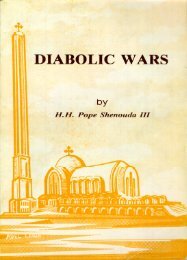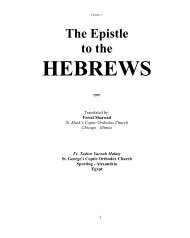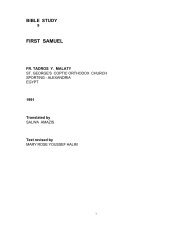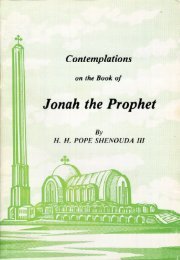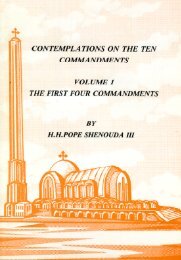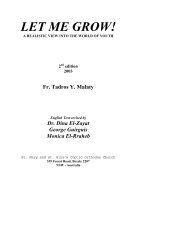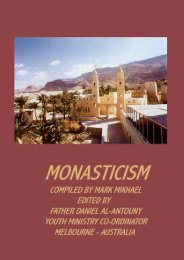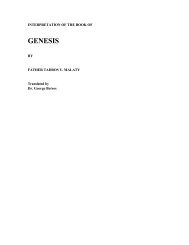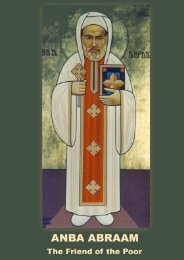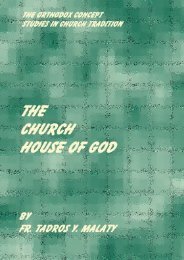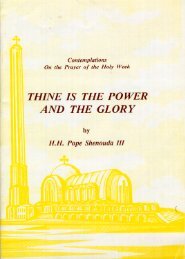The Coptic calendar and the church
The Coptic calendar and the church
The Coptic calendar and the church
Create successful ePaper yourself
Turn your PDF publications into a flip-book with our unique Google optimized e-Paper software.
4It is well known that <strong>the</strong> <strong>Coptic</strong> solar year used to be dividedinto three seasons ra<strong>the</strong>r than four as is currently <strong>the</strong> case.Originally, every season had four full months, with <strong>the</strong> season of<strong>the</strong> rising of <strong>the</strong> Nile coming at <strong>the</strong> head of all <strong>the</strong> seasons. Afterthis came <strong>the</strong> season of planting <strong>and</strong> cultivation, <strong>and</strong> last came<strong>the</strong> season of fruit <strong>and</strong> harvest. Anyone familiar with <strong>the</strong> <strong>Coptic</strong>mass will probably notice that this tripartite division is still usedin <strong>the</strong> liturgical rites of <strong>the</strong> <strong>church</strong>. <strong>The</strong> Church assigns anowshia 2 , or special prayer, to each season. First is <strong>the</strong> owshia for<strong>the</strong> rising of <strong>the</strong> waters, next comes <strong>the</strong> owshia for <strong>the</strong> staplecrops, <strong>and</strong> <strong>the</strong>n comes <strong>the</strong> owshia for <strong>the</strong> winds <strong>and</strong> <strong>the</strong> fruitcrops. Thus <strong>the</strong> <strong>Coptic</strong> year is first <strong>and</strong> foremost tied to <strong>the</strong> Nile,or in o<strong>the</strong>r words it is a Nilotic year.As stated above, <strong>the</strong> <strong>Coptic</strong> year is based on precise stellarobservation <strong>and</strong> minute calculations. This you can actuallyobserve for yourself by looking up at <strong>the</strong> night sky just before <strong>the</strong>beginning of <strong>the</strong> <strong>Coptic</strong> New Year-namely, just before <strong>the</strong>beginning of <strong>the</strong> <strong>Coptic</strong> month of Tut (mid-September). At thattime of <strong>the</strong> year, just before sunrise in <strong>the</strong> eastern sky, you will seea brightly shining star, known to <strong>the</strong> ancient Egyptians as “Stit”but now known to us as Sirius. This star is part of <strong>the</strong>constellation which <strong>the</strong> Romans called <strong>the</strong> Great Dog (CanisMajoris). Because <strong>the</strong> appearance of Sirius was always a portentof <strong>the</strong> Nile’s annual flood, <strong>the</strong> source of life <strong>and</strong> prosperity, thisstar was <strong>the</strong> object of adoration to <strong>the</strong> ancient Egyptians as iswitnessed in <strong>the</strong>ir hymns. Sirius appears close to <strong>the</strong> sun, <strong>and</strong>only once a year, so for this reason <strong>the</strong> Egyptians called it <strong>the</strong>“flood bringer.” <strong>The</strong>y thus adapted <strong>the</strong> <strong>Coptic</strong> year according to<strong>the</strong> course of <strong>the</strong> star, considering <strong>the</strong> moment of its appearance2 This word comes from <strong>the</strong> Greek cJx.fl which means prayer



